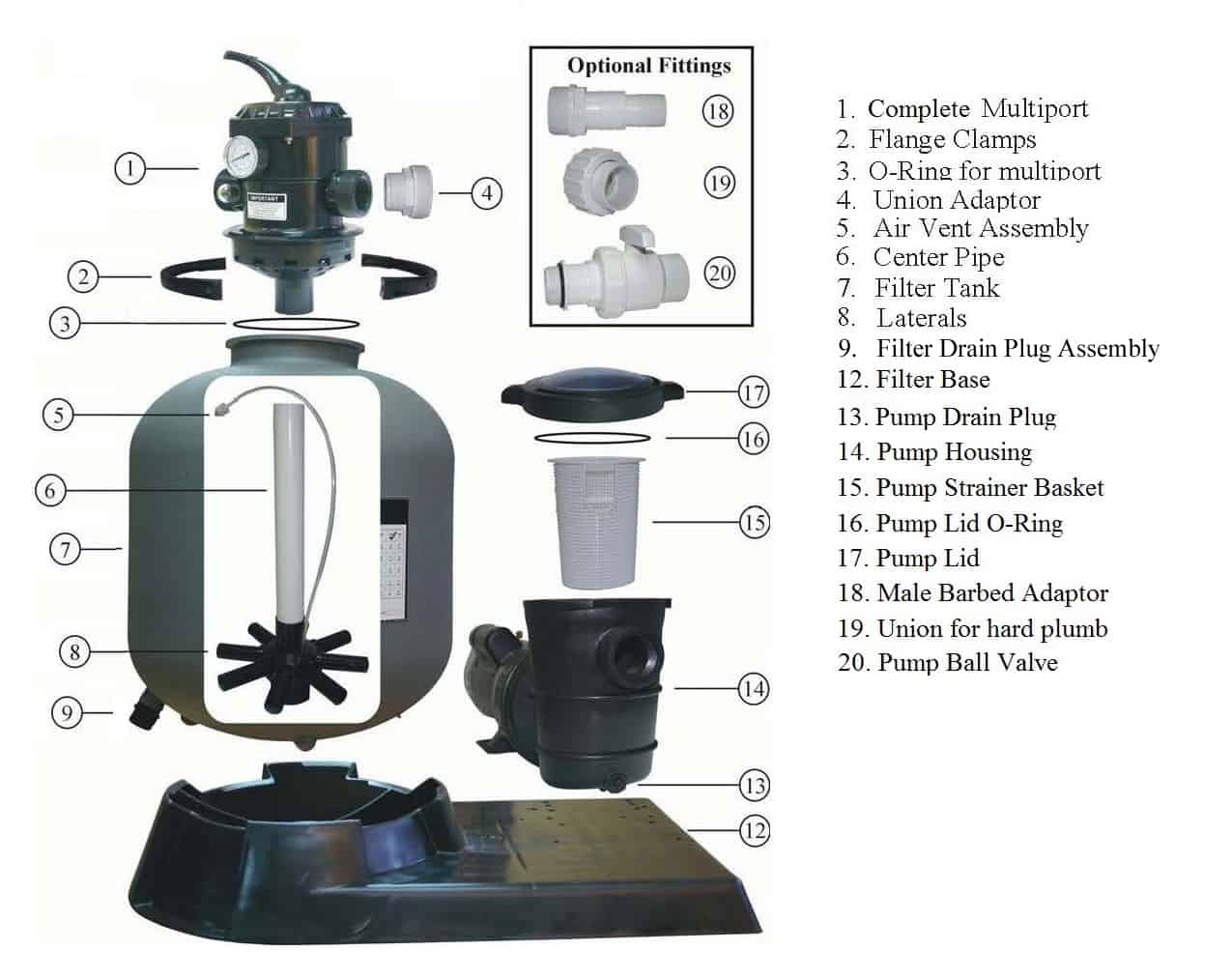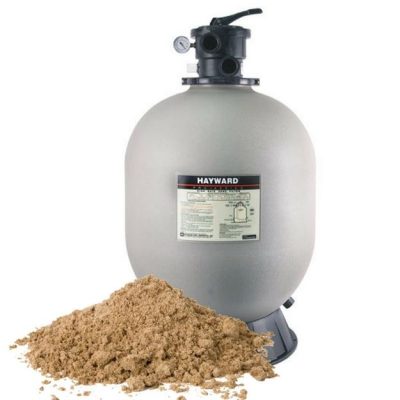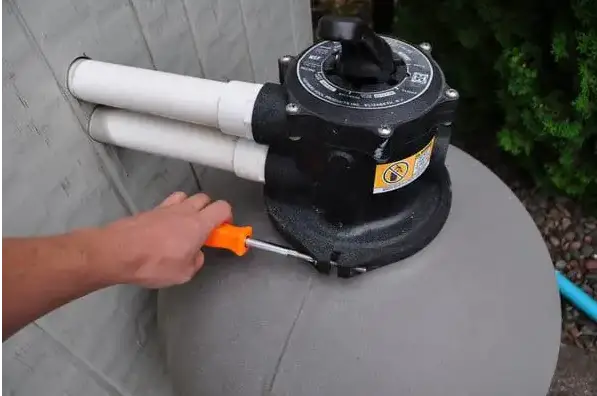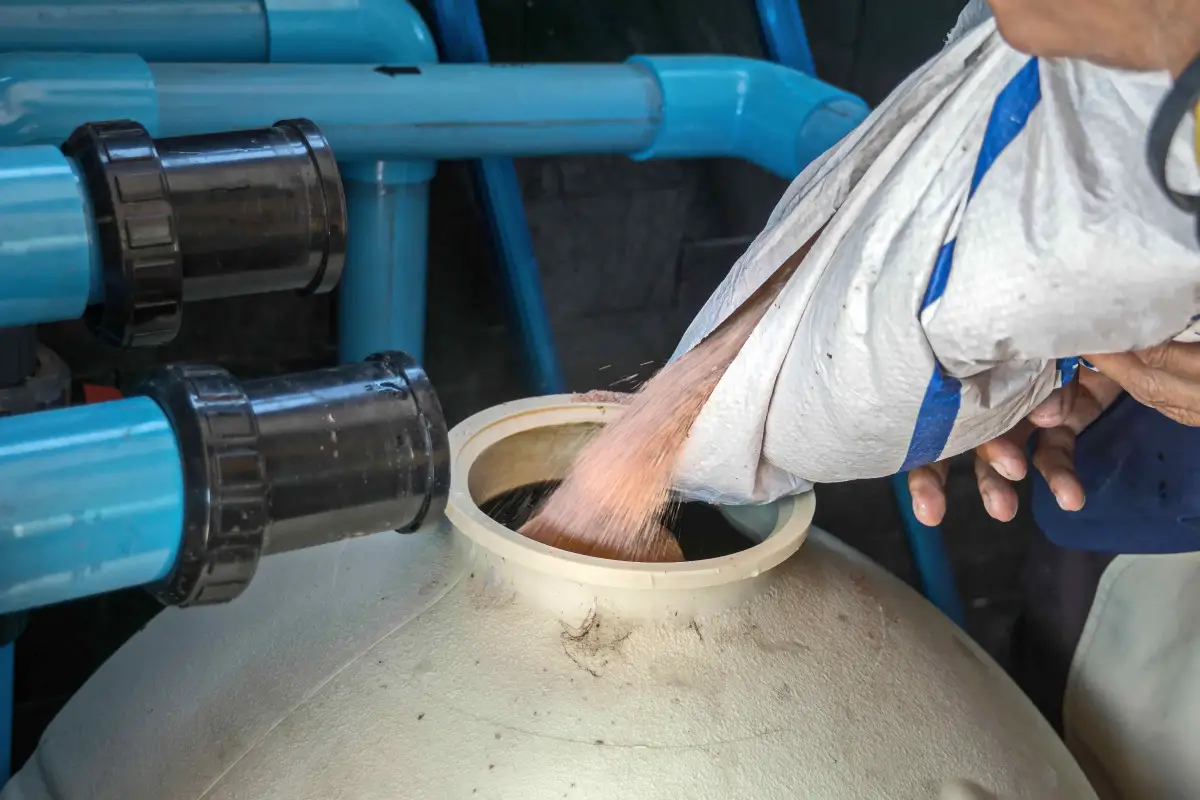If your swimming pool shows signs of cloudy water, there is constant high pressure on the sand Filter’s gauge, even after backwashing. Could it be the sand media in my pool filter? How long does sand media last? When do you change the pool filter sand?
Filter sand needs replacement when:
- Gauge reads high-pressure
- Cloudy H2O despite chemical balance
- Rapid pressure rises post-backwashing
- Poor H2O circulation at jets
- Algae growth despite regular maintenance
- Sand nearing 5 yrs. old
- Visual signs of sand degradation or clumping
- Losing Sand from Filter/backwashing
Keeping a well-maintained swimming pool will save you money throughout the season. If your pool water chemistry is on target and the mechanical part of your system is performing up to par then all signs lead to taking a look at the sand.
When to Change Sand in Pool Filter
When changing the pool filter sand could be the divergent factor in keeping your swimming pool shimmering and the filter functioning efficiently. Dive deep into the world of pool maintenance and let’s caravan through the vital cues signaling it’s time for a sand change.
As any pool owner knows, the pool’s filtration system is the unsung hero in the fight against murky waters. The pool filter sand, comprising countless tiny granules, is tasked with trapping impurities. But here’s the twist: over time, the smooth edges of sand particles wear down, losing their grit and the gripping capability required to ensnare unwanted debris.
You’ll know it’s time to replace pool filter sand typically after three to five years of service—that’s the average lifespan of sand in the cyclical environment of a pool filter. Keep an eye on your swimming pool’s clarity and water chemistry.
If you notice a persistent cloudy appearance or the need for recurrent chemical balancing, consider these as the red flags in your pool sand’s endgame. Also, when your backwashing routine ceases to restore the water’s crystal-clear fame, your pool filter sand’s efficacy is likely on the wane. This is when replacing becomes imperative to ensure your swimming pool remains a bastion of hygiene and clear aesthetics.
Replacing pool filter sand isn’t a horrible task but does require specific know-how and elbow grease. When you’ve decided it’s time for a change, ensure you’re well-informed on the process or consider recruiting a professional’s help. A correct sand change involves not only the removal of old sand but also the insertion of the right type and amount of new sand—key to optimizing your pool’s filter performance.
Recognize the signs, from reduced water clarity to chemically fussy waters, and act promptly. Stick to the suggested timelines and don’t let procrastination muddy your swimming pool paradise. When the sand’s gritty days are behind it, embrace the refresh that comes with a necessary sand change. Engage in this essential task, and your pool will thank you with every sparkling ripple it makes under the sun.

Signs Your Pool’s Sand Filter Needs Changing: Pressure & Clarity
Dive into Pool Maintenance 101, and you’ll discover that crystal-clear water is synonymous with a properly functioning sand filter. However, when that clarity begins to cloud, it’s a tell-tale sign that your filter sand has thrown in the towel. You’ll want to keep a keen eye on your pool water’s transparency. A decrease in visibility means it’s high time to consider replacing the filter sand. With diligent observation, you’ll ensure a sanitary swim haven.
The pressure gauge also offers a wealth of information. An uptick in pressure is a silent alarm for your sand filter’s distress; the build-up of debris within filter sand often results in higher readings on the gauge. Ideally, a well-maintained pool filter maintains a consistent pressure range. Notwithstanding, when the numbers spike beyond the norm, you’ve got enough reason to suspect that the sands of time have affected your sand filter. Don’t disregard these pressure changes; they’re critical cues prompting a filter intervention.
As the seasons rotate, your pool water hosts an array of elements, from leaves to microscopic invaders. Over time, your sand filter may grow weary, struggling to keep up with the relentless assault of debris. It can’t be overstated: Regularly checking your pool’s pressure gauge and water clarity isn’t just a chore—it’s your bulwark against the inevitable. And remember, pool filter upkeep isn’t a luxury but a cornerstone of the crystal-clear aquatic experience you cherish.
Optimizing Pool Health: The Role of Backwashing Before Changing Sand

Dedicated pool maintenance is essential to ensuring optimal pool health, and utilizing methods such as routine backwashing can significantly prolong the life of your sand filter, ultimately saving you time and money.
Backwashing, the process of reversing water flow to flush out contaminants from within the filter, is a crucial step in pool maintenance you shouldn’t neglect, especially before changing sand. It’s like hitting the reset button; by shaking loose all the trapped dirt and debris, you pave the way for a cleaner, more efficient sand replacement.
Consistent backwashing helps maintain a crystal-clear oasis, free from the grime that can clog your filter’s granular bed. Before changing sand, it’s vital to backwash thoroughly, ensuring all accumulated sediments and particulates are expelled.
This pre-change backwash safeguards your pool from unnecessary recirculation of dirt and optimizes the condition of the new filter media, setting a fresh baseline for maintenance. A well-backwash filter means you’re not just piling new sand on top of residues, thereby maximizing pool health and hygiene.
Ideally, pool maintenance schedules mark periodic backwashing as a standard exercise, even if you’re not on the brink of changing sand. Ignoring the role of backwashing could lead to compromised filtration, proving that vigilant maintenance—and not just routine checks—determines the pinnacle of a pool’s health. Signs such as increased pressure gauge readings and murky water quality are your cues that it’s time to act. If you’re nearing the date for changing sand, initiating a robust backwashing cycle will rehabilitate your sand filter’s prowess, ensuring that your maintenance efforts align with the goal of optimal pool perfection.
The frequency of backwashing depends on pool usage and environmental factors, but integrating it into your pool’s maintenance ritual is non-negotiable. In the dance of pool care, backwashing before changing sand is a key step, twirling your maintenance routine towards a harmonious blend of cleanliness and longevity. Master the art of backwashing and witness your pool’s health flourish, making every dip a refreshing embrace by the waters of diligent upkeep.
The Best Time to Replace Pool Sand: Seasonal Tips and Practices
When you’re deep in the throes of pool care – skimming, checking, and balancing – there’s a rhythm to follow, and when it comes to your sand filter, that rhythm demands attention. As summer waves goodbye, and the pool parties dwindle, it’s the perfect moment to replace pool sand.
The end of the season signals a time of less algae and fewer contaminants and thus, it’s a prime time to refresh your filter’s core. Not to mention, engaging in this practice under the comforting embrace of autumn helps avoid the midsummer rush, allowing for a thorough and less hurried maintenance routine.
But what of the springs that beckon life into every nook and cranny? Surely you can’t overlook the allure of prepping your beloved pool or hot tub as the world awakens. Replacing your pool’s filter sand before the first joyful cannonball ensures that your system runs at peak efficiency, catching the remains of winter’s harsh memories before they mar the pure, aquatic treasure.
Remember to stay alert for signs your pool’s sand filter needs changing; high pressure and murky waters are clear distress signals from your aquatic sentinel. And let’s not forget – practices such as regular backwashing are but preliminary steps in the dance of filter care, optimizing pool health, and ensuring those granules can hold off on their retirement a bit longer. So, whether you’re heating up in a seasonal transformation or cooling down from the sun’s relentless tango, make sure to note when to replace pool sand and uphold the sanctity of your splash haven.
Choosing the Right Filter Media: Glass Sand vs. Zeolite Sand

In comparison to glass sand, noted for its longevity and higher filtration performance, against zeolite sand, championed for its ion-exchanging prowess, which traps ammonia and reduces eye-irritating chloramines.
Transitioning from the commonly used silica sand, many pool owners are now opting for these advanced alternatives when debating filter media options. Glass sand, with its smooth, angular edges, doesn’t clump or channel, ensuring a finer filtration, typically down to 5 microns, whereas the natural alchemy of zeolite sand, with its microporous structure, offers an unparalleled ability to filter down particles to an impressive 3 microns.
Both pool filters boast an extended lifespan when compared to traditional silica sand. This progressive shift in trend calls for a well-informed decision when choosing filter media that aligns with your pool’s needs. Glass sand is revered for its robustness and resistance to bio-fouling, thereby necessitating lesser backwashing and heralding eco-friendly water conservation. On the flip side, the zeolite sand, porous and volcanic, excels in ammonia absorption, securing a reduction in chemical usage and maintaining a harmonious balance of water chemistry.
Pool filters empowered with either glass sand or zeolite sand are investments in the prolonged health of your swimming sanctuary. So, when the sands of time dictate a filter sand change, consider the characteristics that make the right filter media for your situation.
Does your pool suffer from heavy use, necessitating the hard-wearing durability of glass sand, or is the eco-sensitive, zeolite sand more your speed, with its eye towards fewer chemicals and enhanced water clarity? Acknowledge these insights to ensure your choice in pool filters delivers a swimmable masterpiece, timelessly inviting and consistently clear, shy of any subpar speculations. Indeed, replacing filter sand isn’t just routine maintenance, it’s a strategic move toward the zenith of aquatic elegance.
Changing Pool Filter Sand: A Step-by-Step Guide
With this concise step-by-step guide, you’ll be maneuvering through the process like a seasoned pro. Whether you’re dealing with a small backyard above-ground or a large in-ground pool, maintaining your pool’s filter sand is crucial for crystal-clear water and efficient filtration. Firstly, you must recognize the tell-tale signs that your pool’s sand filter needs changing, such as notable pressure fluctuations and a lack of water clarity. Paying heed to these alarms ensures you’re changing the sand only when
Before you embark on this task, it’s important to understand the correct steps to effectively change pool filter sand. The process is not overly complicated, but it does require attention to detail and adherence to safety measures. Use These Steps:
- Turn off the pool pump: Ensure the pump is switched off to stop water flow during the process.

When To Change Pool Filter Sand - Close valves: Shut off any relevant valves to prevent water from entering the filter system.
- Release pressure: Open the air relief valve on the filter to release any built-up pressure.
- Remove the filter cover: Take off the dome or cover to access the filter tank.
- Scoop out the old sand: Carefully scoop out the existing sand using a plastic scoop or your hands.
- Clean the filter tank: Thoroughly clean the interior of the filter tank to remove any debris or remaining sand.
- Add new sand: Pour the recommended amount of new pool filter sand into the tank.
- Reassemble the filter: Put the filter cover back in place and secure it tightly.
- Turn on the pump: Restart the pool pump and open the necessary valves.
- Check for leaks: Monitor the system for any leaks and address them promptly if detected.
- Backwash and rinse: Perform a backwash and rinse cycle to remove any residual impurities from the new sand.
- Monitor pressure: Keep an eye on the filter pressure and backwash as needed based on manufacturer recommendations.

necessary, optimizing your pool’s health without unnecessary labor.
Oftentimes, you’ll need to change the sand after a period of 5 to 7 years, but this can vary based on usage and the type of sand filters you have installed.
For a foolproof change, let’s dive into the instructions that’ll guide you through this transformative undertaking. Initially, you’ll want to backwash the filter, a preparatory step that rids the existing sand of impurities, easing the transition to fresh, new sand.
Once backwashed, switch off the filter system and commence the extraction of old sand, taking care to dispose of it responsibly. Now comes the pivotal moment; gently introduce the new pool filter sand, ensuring you don’t damage the filter’s internal components.
Throughout the procedure, it’s vital to adhere closely to the manufacturer’s instructions, as they can differ slightly for various sand pool filter models. The change, intriguingly, offers an ideal moment to consider a switch to alternative filter media, such as glass sand or zeolite sand, each boasting unique filtering qualities. After completing the change, your pool’s filter will be ready to tackle the demands of uninterrupted splash-filled fun.
Maintaining Your Pool: How to Change Your Filter Sand Without Risks

Maintaining your pool is no small feat; it ensures the splendid sparkle and safety of your backyard oasis. A critical aspect of pool care is knowing how to change filter sand, which works tirelessly to keep your water pristine. But, let’s face it, maneuvering through the task without risks is pivotal. You’d want to ensure the safety of both yourself and your swimming sanctum. Whether you’re a newbie to pool maintenance or a seasoned veteran, it’s vital to grasp the how-tos of handling sand filters with due diligence.
Understanding when it’s time to give your pool pump’s companion, the sand filter, a refresh can be a bit of a puzzle.
The trick lies in observing signs of weariness, like a drop in water quality or a soaring pressure gauge, signaling that the sands of time demand a change. Pool care aficionados suggest a strategic approach – backwashing the filter before making the switch to new sand, thus optimizing pool health. But remember your commitment to safety shouldn’t wane during this process; always turn off the pump before you dive into the task.
Changing pool filter sand is a crucial step in every pool owner’s maintenance schedule nevertheless, the type of filter media chosen can be a game-changer. It’s a toss-up between the traditional and dependable filter sand, avant-garde glass sand, or the super-efficient Zeolite sand. Each contender has its merits, yet your pool’s demand and your personal preference hold the reins to this decision.
Executing the change requires vigilance. As you weave through the necessary steps, ensuring your pump’s integrity and preventing any inadvertent mishaps stands paramount. From properly securing the pump to cautiously replacing the sand, every move should be calculated. After all, maintaining your pool is about crafting an aquatic retreat that’s not just visually entrancing but also mechanically sound and safe for every joyous plunge.
The Longevity of Pool Sand: When Backwashing Isn’t Enough
How long will the granules within my sand filter bear the burden of cleanliness before they falter? When backwashing isn’t enough, when the arms of this essential maintenance step no longer embrace the impurities with the vigor they once did, it’s time to ponder the realities of pool filter sand replacement.
Your pool’s performance could be a symphony of filtration perfection, yet there’s an inevitable curtain call for even the most diligent sand filter. The glisten of your pool water can begin to dim, signaling the need to refresh what lies hidden within the filter. Despite consistent backwashing—an act designed to prolong the life of your sand’s ability to purify—there comes a time when clarity can no longer be restored, and pressure mounts within the system. It’s the tell-tale sign that your pool’s sand filter needs changing, a rite of passage for every well-tended basin.
Seizing the most opportune season could be the difference between a seamless transition and a turbulent turnover in your pool care routine. The best time to replace pool sand often aligns with the whispers of a departing summer or the first breath of spring—a seasonal tip practiced by the guardians of the great blue lounge. Once the decision is made, the choice between the traditional silica sand, the refined glass sand, and the volcanic zeolite sand lies before you. Each media offers a unique embrace to your pool’s liquid heart, with longevity and performance as the guiding stars.
Though the process of changing pool filter sand can seem as daunting as taming Poseidon’s chariot, fear not—the step-by-step guide ensures that maintaining your pool, that dynamic bastion of leisure will be stripped of risks and rife with rewards. So, when backwashing isn’t enough, when the dance of the diatoms within the filter grows weary, trust in the signs and the cycles to guide you. For it is the steward of the pool, armed with knowledge and sagacity, who ensures that the waters remain ever inviting, ever pure.
Conclusion:
In conclusion, the timing for changing pool filter sand is crucial for maintaining optimal filtration and water clarity. By monitoring pressure, water clarity, age of the sand, and visual signs of degradation, pool owners can determine when it’s necessary to replace the filter media. Regular maintenance and timely replacements ensure efficient filtration and a clean swimming environment for enjoyment throughout the swimming season.
References:
My Perfect Pool- When to Change the Sand in the Pool Filter (And the Risks)
FAQ’s
How do I know if my pool filter sand is working?
Add diatomaceous earth (DE) to your pool skimmer, and stick to around a scoop or two – no more than the size of a 1lb coffee cup. The moment you do this, go to the pool jets to see if it is returning DE into the pool, or if the water suddenly looks cloudy. If it is, you likely have an issue with your filter.
How often should I clean the sand in my pool filter?
A sand filter usually only needs to be cleaned every 5 years or so. A DE filter requires cleaning at least once annually. To clean it, remove the internal grid assembly and clean it well. A cartridge filter doesn’t backwash.
What is the life expectancy of a pool sand filter?
Sand filters will often be able to perform for around three-to-seven years, depending on use. If you frequently clean and backwash your filter and only use the pool seasonally, you can expect to replace it after at least five years


